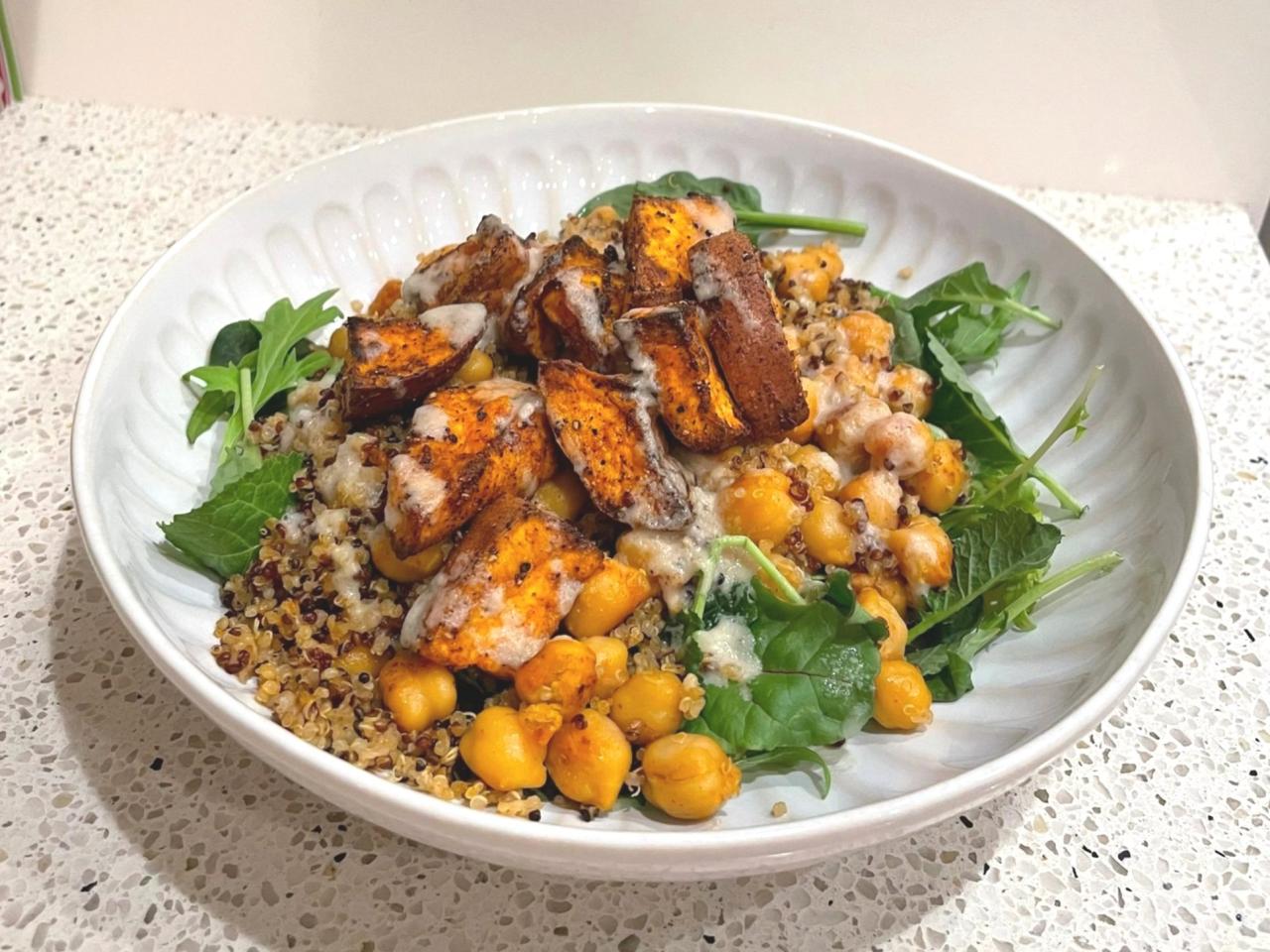
Sweet Potato and Roasted Chickpea Bowl: A Flavorful and Healthy Meal
Sweet Potato and Roasted Chickpea Bowl is a delicious and nutritious meal that’s perfect for any occasion. This versatile dish can be enjoyed as a complete meal or a hearty side dish, and it’s packed with flavor and nutrients. The combination of sweet potatoes and roasted chickpeas provides a satisfying blend of carbohydrates, protein, and fiber, making it a great choice for those looking for a healthy and balanced meal.
This bowl is also incredibly adaptable, allowing you to customize it with your favorite flavors and ingredients. From Mediterranean to Indian and Mexican, there are endless possibilities to explore.
Preparing the Sweet Potato and Roasted Chickpea Bowl

This delightful bowl combines the sweetness of roasted sweet potatoes with the savory crunch of roasted chickpeas, making it a satisfying and healthy meal. The preparation is simple and can be customized to your taste preferences.
Roasting Chickpeas
Roasted chickpeas are a versatile ingredient that can be enjoyed as a snack or added to salads, bowls, and other dishes. They are easy to prepare and can be seasoned with various spices and herbs to create unique flavor profiles.To roast chickpeas, start by rinsing and drying a can (or 1.5 cups) of chickpeas.
Sometimes you just crave a hearty, comforting bowl, and that’s where my sweet potato and roasted chickpea bowl comes in. It’s packed with flavor and texture, but I’m always looking for ways to elevate it. That’s where thinking outside the lox comes in – a great resource for unique flavor combinations.
I’ve recently been experimenting with adding a drizzle of tahini and a sprinkle of toasted sesame seeds for a touch of nutty richness, and it’s been a game-changer!
Spread them evenly on a baking sheet lined with parchment paper. Drizzle with olive oil and season with your desired spices. Some popular options include:
- Classic Seasoning:Salt, pepper, garlic powder, onion powder
- Mediterranean Flavors:Smoked paprika, cumin, oregano, lemon zest
- Spicy Kick:Cayenne pepper, chili powder, cumin
- Sweet and Savory:Maple syrup, cinnamon, nutmeg
Roast the chickpeas in a preheated oven at 400°F (200°C) for 30-40 minutes, stirring occasionally, until they are crispy and golden brown. Let them cool completely before using.
Preparing Sweet Potatoes, Sweet potato and roasted chickpea bowl
Sweet potatoes can be prepared in several ways, each offering a unique texture and flavor. Here are some popular methods:
- Baking:Baking is a simple and straightforward method for preparing sweet potatoes. Simply pierce the sweet potatoes with a fork a few times to prevent them from exploding in the oven. Place them on a baking sheet lined with parchment paper and bake in a preheated oven at 400°F (200°C) for 45-60 minutes, or until tender.
- Roasting:Roasting is similar to baking, but it often results in a more caramelized and flavorful sweet potato. Cut the sweet potatoes into cubes or wedges, toss them with olive oil and your desired seasonings, and roast in a preheated oven at 400°F (200°C) for 20-25 minutes, or until tender and slightly browned.
Sweet potato and roasted chickpea bowls are a favorite of mine, especially when I’m craving something warm and comforting. They’re so versatile and easy to customize with different toppings and sauces. I also love the similar flavors and textures in mushrooms brussels sprouts tofu grain bowls , which offer a delicious vegetarian alternative.
Both bowls are packed with nutrients and flavor, making them a satisfying and healthy meal option.
- Grilling:Grilling imparts a smoky flavor to sweet potatoes. Cut them into thick slices or wedges and brush them with olive oil and seasonings. Grill over medium heat for 10-15 minutes, turning occasionally, until they are tender and slightly charred.
Once your sweet potatoes are cooked, you can mash them, slice them, or dice them according to your preference.
My sweet potato and roasted chickpea bowl is a light and flavorful meal, perfect for a weeknight dinner. But sometimes I crave something warm and hearty, which is when I turn to my favorite butternut squash black bean chili recipe.
The chili’s rich flavor and satisfying texture perfectly complement the sweetness of the sweet potato and chickpeas, making for a delicious and balanced meal.
Flavor Combinations and Variations

This sweet potato and roasted chickpea bowl is incredibly versatile, allowing you to explore various flavor profiles and create a dish that perfectly suits your taste. By changing up the seasonings and additional ingredients, you can transform this simple bowl into a culinary adventure.
Flavor Combinations
You can easily customize this bowl by incorporating different flavor profiles. Here’s a table showcasing some exciting combinations:
| Flavor Profile | Sweet Potato Preparation | Chickpea Seasoning | Additional Ingredients |
|---|---|---|---|
| Mediterranean | Roasted with olive oil, garlic, and oregano | Spiced with cumin, paprika, and turmeric | Chopped cucumbers, tomatoes, red onion, Kalamata olives, and a drizzle of lemon juice |
| Indian | Roasted with curry powder, ginger, and garlic | Spiced with garam masala, coriander, and cumin | Chopped cilantro, diced red onion, and a dollop of yogurt |
| Mexican | Roasted with chili powder, cumin, and smoked paprika | Spiced with chili powder, cumin, and garlic powder | Chopped bell peppers, corn, black beans, and a sprinkle of fresh cilantro |
| Asian-Inspired | Roasted with soy sauce, ginger, and sesame oil | Spiced with sesame seeds, chili flakes, and garlic powder | Chopped green onions, shredded carrots, and a drizzle of sesame oil |
Serving Suggestions and Presentation

This sweet potato and roasted chickpea bowl is a versatile dish that can be enjoyed in a variety of ways. Whether you’re looking for a light and healthy lunch or a hearty and satisfying dinner, there’s a serving suggestion to suit your taste.
Serving Style Options
Here are some creative ways to serve your sweet potato and roasted chickpea bowl:
| Serving Style | Description | Image Description | Tip |
|---|---|---|---|
| Salad Bowl | Combine the sweet potato and roasted chickpea bowl with a bed of mixed greens, chopped vegetables, and a light vinaigrette dressing. | A vibrant bowl filled with a colorful mix of greens, chopped tomatoes, cucumbers, and red onions. On top of the salad, a generous portion of the sweet potato and roasted chickpea bowl is arranged, creating a visually appealing and healthy combination. | Choose a vinaigrette dressing that complements the flavors of the bowl, such as a lemon-herb or balsamic vinaigrette. |
| Protein-Packed Bowl | Add a protein source to your bowl, such as grilled chicken, tofu, or tempeh. | A bowl showcasing the sweet potato and roasted chickpea bowl with a generous portion of grilled chicken breast on top. The chicken is slightly charred, adding a smoky flavor to the dish. | Choose a protein that complements the flavors of the bowl. For example, grilled chicken or tofu would pair well with the sweet potato and chickpeas. |
| Topped with a Sauce | Elevate your bowl by adding a flavorful sauce, such as tahini dressing, yogurt sauce, or a spicy chili sauce. | The sweet potato and roasted chickpea bowl is presented with a dollop of creamy tahini dressing on top. The dressing is drizzled with a few drops of olive oil, adding a richness to the dish. | Experiment with different sauces to find your favorite combination. |
| Warm and Cozy Bowl | Serve the bowl warm with a sprinkle of fresh herbs and a drizzle of olive oil. | The bowl is steaming, with the sweet potato and roasted chickpeas glistening with a drizzle of olive oil. A sprig of fresh parsley adds a touch of color and freshness. | Use a warm bowl to keep the dish warm and flavorful. |
Ending Remarks
Whether you’re a seasoned cook or a beginner in the kitchen, this recipe is easy to follow and delivers amazing results. The sweet potato and roasted chickpea bowl is a versatile dish that can be enjoyed year-round, offering a delicious and healthy meal that’s sure to please everyone.
So, next time you’re looking for a quick and satisfying meal, give this recipe a try. You won’t be disappointed!

